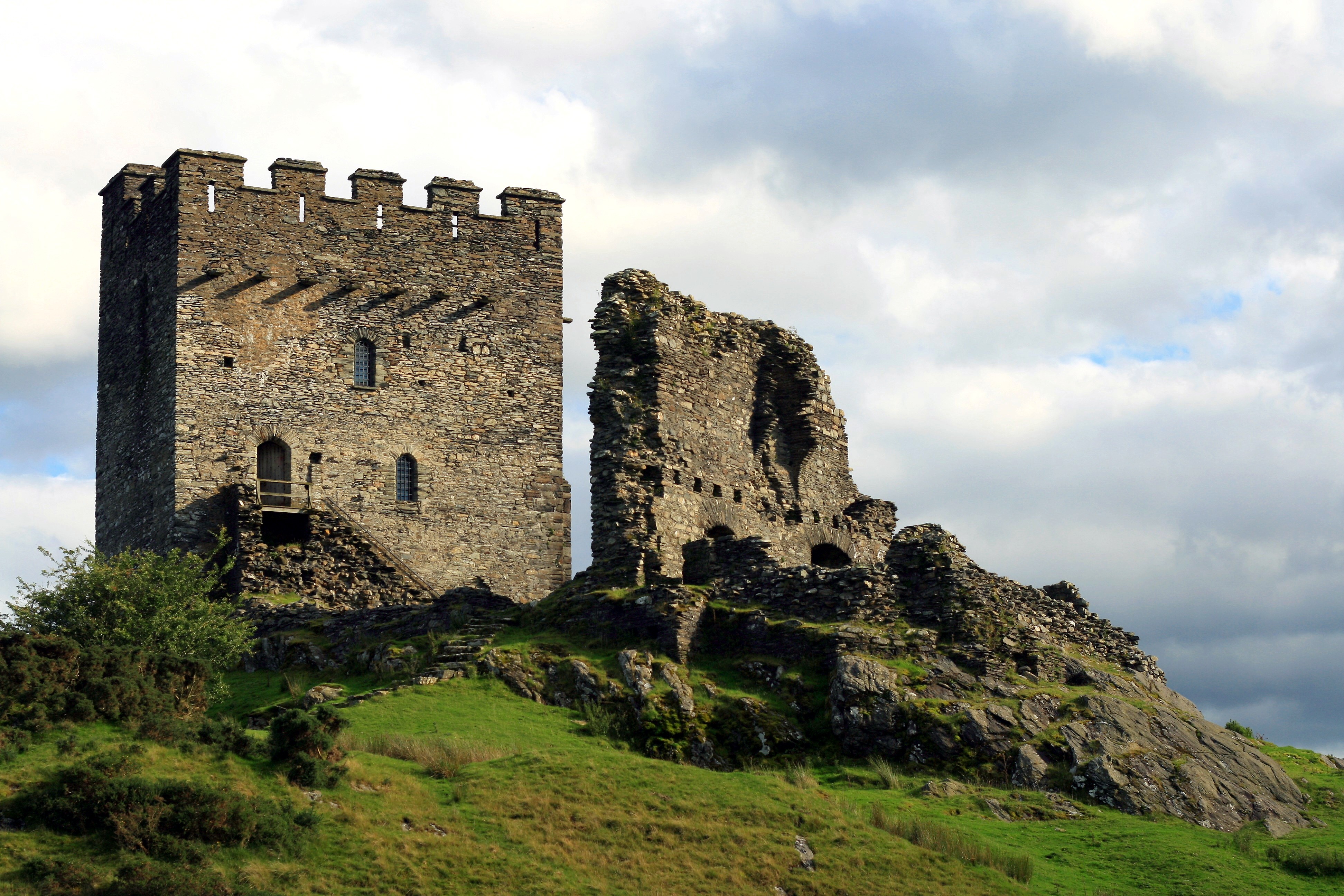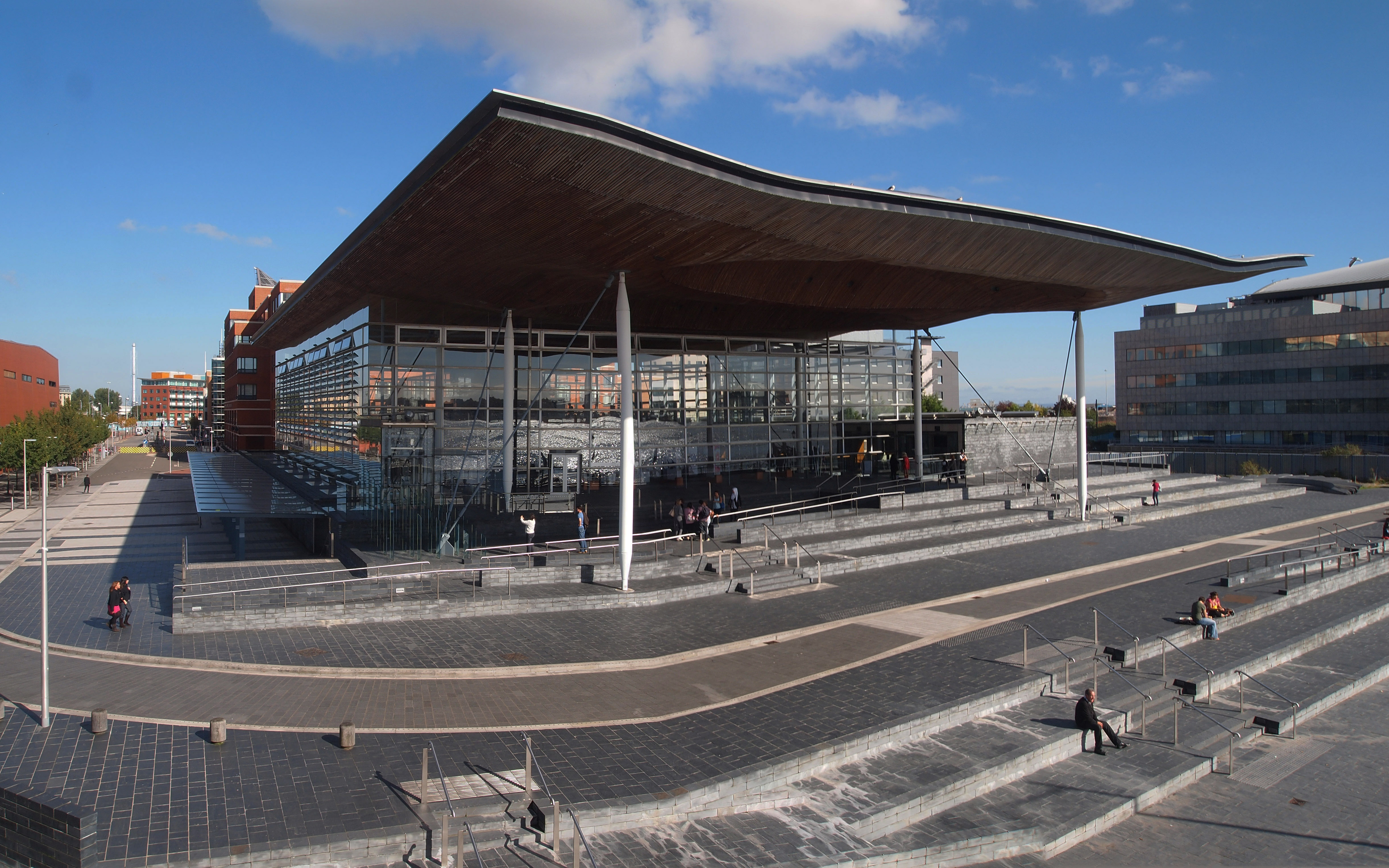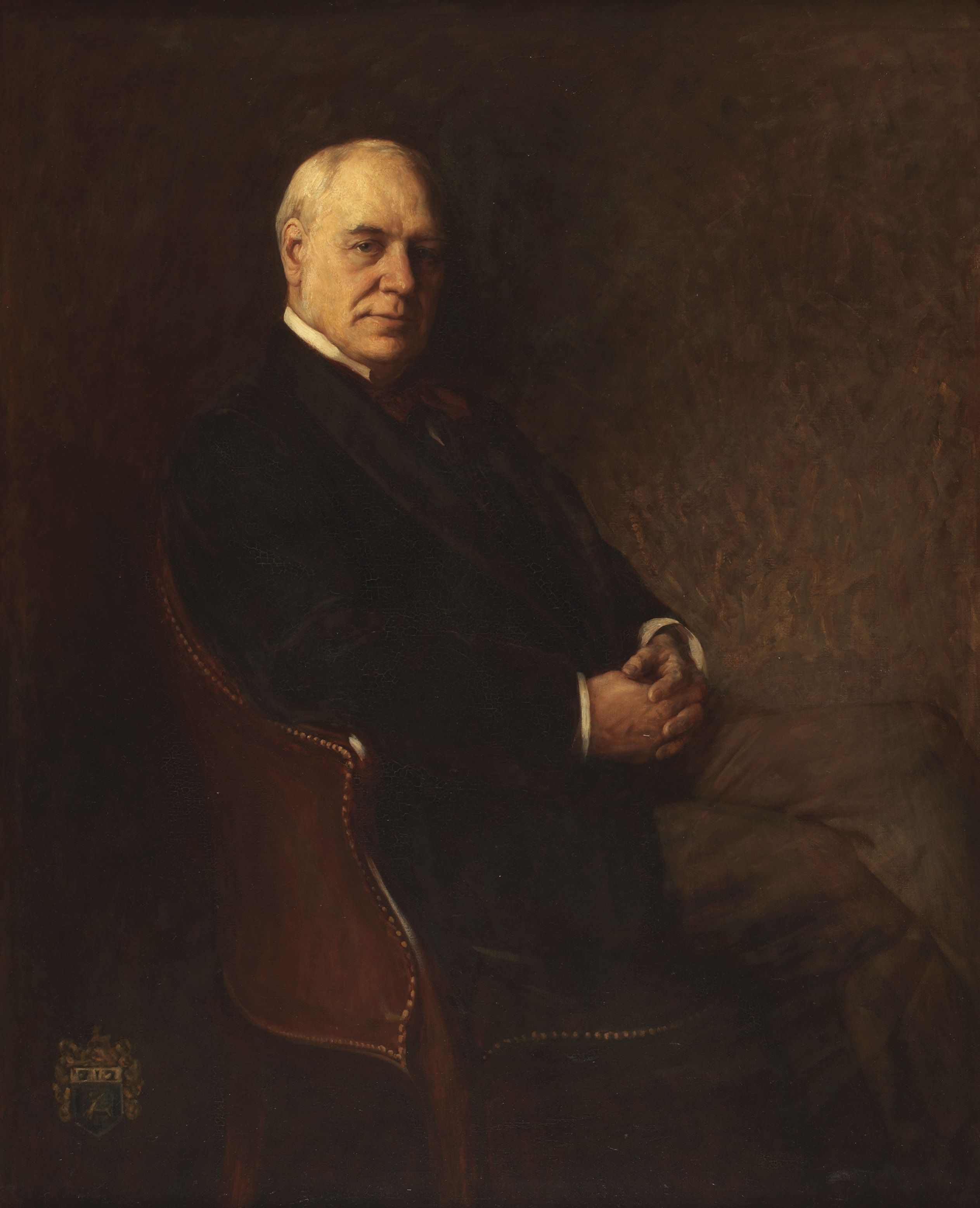|
Pennal Tower
Pennal is a village and community on the A493 road in southern Gwynedd, Wales, on the north bank of the Afon Dyfi/ River Dovey, near Machynlleth. It lies in the historic county of Merionethshire/ Sir Feirionnydd and is within the Snowdonia National Park. Roman fort It was the site of a small Roman fort, known as Cefn Caer in Welsh, probably guarding a ford or ferry crossing of the Dyfi on the Sarn Helen Roman road. The remains of the fort lie under the 14th-century house of Cefn Caer, overlooking the village. Price Family of Esgair Weddan Just outside Pennal is the farmstead of 'Esgair Weddan' which from the 14th century until the mid 18th was the home of the Price (ap Rhys) family of Esgair Weddan, patrilineal descendants of Dafydd ap Llywelyn, son of Llywelyn fawr (the great) Prince of Wales (1240–1246). Their home was called Plas yn y Rofft in Elizabethan times and was located in a field behind the present farmhouse above the village of Cwrt, (originally Pont y ... [...More Info...] [...Related Items...] OR: [Wikipedia] [Google] [Baidu] |
Gwynedd
Gwynedd (; ) is a county and preserved county (latter with differing boundaries; includes the Isle of Anglesey) in the north-west of Wales. It shares borders with Powys, Conwy County Borough, Denbighshire, Anglesey over the Menai Strait, and Ceredigion over the River Dyfi. The scenic Llŷn Peninsula and most of Snowdonia National Park are in Gwynedd. Bangor is the home of Bangor University. As a local government area, it is the second largest in Wales in terms of land area and also one of the most sparsely populated. A majority of the population is Welsh-speaking. ''Gwynedd'' also refers to being one of the preserved counties of Wales, covering the two local government areas of Gwynedd and Anglesey. Named after the old Kingdom of Gwynedd, both culturally and historically, ''Gwynedd'' can also be used for most of North Wales, such as the area that was policed by the Gwynedd Constabulary. The current area is , with a population of 121,874 as measured in the 2011 Census. Et ... [...More Info...] [...Related Items...] OR: [Wikipedia] [Google] [Baidu] |
Llywelyn Fawr
Llywelyn the Great ( cy, Llywelyn Fawr, ; full name Llywelyn mab Iorwerth; c. 117311 April 1240) was a King of Kingdom of Gwynedd, Gwynedd in north Wales and eventually "List of rulers of Wales, Prince of the Welsh" (in 1228) and "Prince of Wales" (in 1240). By a combination of war and diplomacy he dominated Wales for 45 years. During Llywelyn's childhood, Gwynedd was ruled by two of his uncles, who split the kingdom between them, following the death of Llywelyn's grandfather, Owain Gwynedd, in 1170. Llywelyn had a strong claim to be the legitimate ruler and began a campaign to win power at an early age. He was sole ruler of Gwynedd by 1200 and made a treaty with King John of England that year. Llywelyn's relations with John remained good for the next ten years. He married John's natural daughter Joan, Lady of Wales, Joan in 1205, and when John arrested Gwenwynwyn of Powys in 1208, Llywelyn took the opportunity to annex southern Powys. In 1210, relations deteriorated, and John i ... [...More Info...] [...Related Items...] OR: [Wikipedia] [Google] [Baidu] |
Owain Gwynedd
Owain ap Gruffudd ( 23 or 28 November 1170) was King of Gwynedd, North Wales, from 1137 until his death in 1170, succeeding his father Gruffudd ap Cynan. He was called Owain the Great ( cy, Owain Fawr) and the first to be styled "Prince of Wales". He is considered to be the most successful of all the North Welsh princes prior to his grandson, Llywelyn the Great. He became known as Owain Gwynedd ( wlm, Owain Gwyned, "Owain of Gwynedd") to distinguish him from the contemporary king of Powys Wenwynwyn, Owain ap Gruffydd ap Maredudd, who became known as Owain Cyfeiliog. Early life Owain Gwynedd was a member of the House of Aberffraw, the senior branch of the dynasty of Rhodri the Great. His father, Gruffudd ap Cynan, was a strong and long-lived ruler who had made the principality of Gwynedd the most influential in Wales during the sixty-two years of his reign, using the island of Anglesey as his power base. His mother, Angharad ferch Owain, was the daughter of ... [...More Info...] [...Related Items...] OR: [Wikipedia] [Google] [Baidu] |
Rhodri Mawr
Rhodri ap Merfyn ( 820 – 873/877/878), popularly known as Rhodri the Great ( cy, Rhodri Mawr), succeeded his father, Merfyn Frych, as King of Kingdom of Gwynedd, Gwynedd in 844. Rhodri annexed Kingdom of Powys, Powys c. 856 and Seisyllwg c. 871. He is called "King of the Britons" by the ''Annals of Ulster.'' In some later histories, he is referred to as "King of Wales", although the title is anachronistic and his realm did not include southern Wales. Lineage and inheritance Rhodri was the son of King Merfyn Frych, who had claimed Kingdom of Gwynedd, Gwynedd upon the extinction of Cunedda's male line. Rhodri then inherited the realm after his father's death around 844. Merfyn hailed from "Manaw" which may either refer to the Isle of Man or Manau Gododdin, Manau, the ancestral homeland of all Gwynedd's kings since Cunedda. According to later genealogies, his mother or grandmother was Nest ferch Cadell of the ruling dynasty in Kingdom of Powys, Powys, and Rhodri inherited the ... [...More Info...] [...Related Items...] OR: [Wikipedia] [Google] [Baidu] |
Patrilinear Descent
Patrilineality, also known as the male line, the spear side or agnatic kinship, is a common kinship system in which an individual's family membership derives from and is recorded through their father's lineage. It generally involves the inheritance of property, rights, names, or titles by persons related through male kin. This is sometimes distinguished from cognate kinship, through the mother's lineage, also called the spindle side or the distaff side. A patriline ("father line") is a person's father, and additional ancestors, as traced only through males. Traditionally and historically people would identify the person's ethnicity with the father's heritage and ignore the maternal ancestry in the ethnic factor. In the Bible In the Bible, family and tribal membership appears to be transmitted through the father. For example, a person is considered to be a priest or Levite, if his father is a priest or Levite, and the members of all the Twelve Tribes are called Israelites because ... [...More Info...] [...Related Items...] OR: [Wikipedia] [Google] [Baidu] |
Llugwy Hall
Llugwy is the name of an old property near Pennal, a village on the A493 road in southern Gwynedd, Wales, on the north bank of the Afon Dyfi/River Dovey, near Machynlleth. It lies in the former county of Merionethshire/Sir Feirionnydd, and is within the Snowdonia National Park. Llugwy was the home of the Anwyl family since 1682. Maurice Anwyl (c.1645-c.1695), son of Evan (Ieuan) Anwyl of Brynkir, and the first of the family to live at Llugwy, is recorded by Thomas Nicholas in ''Annals and antiquities of the counties and county families of Wales'' (1872); "The ancient family of Anwyl have resided at Llugwy from the time when Maurice Anwyl (circa 1695) m. Joan, the heiress of that place, but previously for many ages at Parc, in the parish of Llanfrothen, in the same county of Merionethshire. There Lewys Dwnn, Deputy Herald, found them, in the 16th Century, when pursuing his ''Heraldic Visitation of Wales''; and there they had then been seated for several generations. Their lin ... [...More Info...] [...Related Items...] OR: [Wikipedia] [Google] [Baidu] |
Morben
Morben is a hamlet in northern Powys, Wales. Part of the historic county of Montgomeryshire ( Sir Drefaldwyn) from 1536 to 1974, it lies on the Afon Dyfi and was once the home of a number of riverside quays, including Cei Ward and Y Bwtri. The site of Cei Ward lies alongside the A487 opposite Plas Llugwy, where the road, railway and river run close together. Y Bwtri lay on the bend of the river opposite Pennal and was the site of a shipyard. The narrow gauge Corris, Machynlleth & River Dovey Tramroad (opened 1859) carried slate from the quarries around Corris and Aberllefenni to Morben, where it was loaded into ships for onward shipment. At around the time the tramway became the Corris Railway in the early 1860s the Aberystwith and Welsh Coast Railway extended the standard gauge rails west of Machynlleth, and soon after the section of the Tramroad west of Machynlleth was abandoned and slate was instead trans-shipped to main line trains. Inward goods offloaded at Morben would ha ... [...More Info...] [...Related Items...] OR: [Wikipedia] [Google] [Baidu] |
Cardiff
Cardiff (; cy, Caerdydd ) is the capital and largest city of Wales. It forms a principal area, officially known as the City and County of Cardiff ( cy, Dinas a Sir Caerdydd, links=no), and the city is the eleventh-largest in the United Kingdom. Located in the south-east of Wales and in the Cardiff Capital Region, Cardiff is the county town of the historic county of Glamorgan and in 1974–1996 of South Glamorgan. It belongs to the Eurocities network of the largest European cities. A small town until the early 19th century, its prominence as a port for coal when mining began in the region helped its expansion. In 1905, it was ranked as a city and in 1955 proclaimed capital of Wales. Cardiff Built-up Area covers a larger area outside the county boundary, including the towns of Dinas Powys and Penarth. Cardiff is the main commercial centre of Wales as well as the base for the Senedd. At the 2021 census, the unitary authority area population was put at 362,400. The popula ... [...More Info...] [...Related Items...] OR: [Wikipedia] [Google] [Baidu] |
National Assembly For Wales
The Senedd (; ), officially known as the Welsh Parliament in English language, English and () in Welsh language, Welsh, is the Devolution in the United Kingdom, devolved, unicameral legislature of Wales. A democratically elected body, it makes laws for Wales, agrees certain taxes and scrutinises the Welsh Government. It is a bilingual institution, with both Welsh language, Welsh and English language, English being the official languages of its business. From its creation in May 1999 until May 2020, the Senedd was known as the National Assembly for Wales ( cy, Cynulliad Cenedlaethol Cymru, lang, link=no). The Senedd comprises 60 members who are known as Member of the Senedd, Members of the Senedd (), abbreviated as "MS" (). Since 2011, members are elected for a five-year term of office under an additional member system, in which 40 MSs represent smaller geographical divisions known as Senedd constituencies and electoral regions, "constituencies" and are elected by first-past-the ... [...More Info...] [...Related Items...] OR: [Wikipedia] [Google] [Baidu] |
National Library Of Wales
The National Library of Wales ( cy, Llyfrgell Genedlaethol Cymru), Aberystwyth, is the national legal deposit library of Wales and is one of the Welsh Government sponsored bodies. It is the biggest library in Wales, holding over 6.5 million books and periodicals, and the largest collections of archives, portraits, maps and photographic images in Wales. The Library is also home to the national collection of Welsh manuscripts, the National Screen and Sound Archive of Wales, and the most comprehensive collection of paintings and topographical prints in Wales. As the primary research library and archive in Wales and one of the largest research libraries in the United Kingdom, the National Library is a member of Research Libraries UK (RLUK) and the Consortium of European Research Libraries (CERL). At the very core of the National Library of Wales is the mission to collect and preserve materials related to Wales and Welsh life and those which can be utilised by the people of Wales fo ... [...More Info...] [...Related Items...] OR: [Wikipedia] [Google] [Baidu] |
Charles VI Of France
Charles VI (3 December 136821 October 1422), nicknamed the Beloved (french: le Bien-Aimé) and later the Mad (french: le Fol or ''le Fou''), was King of France from 1380 until his death in 1422. He is known for his mental illness and psychotic episodes that plagued him throughout his life. He ascended the throne at the young age of eleven, his father leaving behind a favorable military situation, marked by the reconquest of most of the English possessions in France. First placed under the regency of his uncles, the Dukes of Burgundy, Anjou, Berry, and Bourbon, Charles decided in 1388, aged 20, to emancipate himself. In 1392, while leading a military expedition against the Duchy of Brittany, the king had his first attack of delirium, during which he attacked his own men in the forest of Le Mans. A few months later, following the Bal des Ardents (January 1393) where he narrowly escaped death from burning, Charles was again placed under the regency of his uncles, the dukes of Berry ... [...More Info...] [...Related Items...] OR: [Wikipedia] [Google] [Baidu] |



